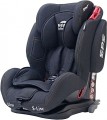Installation
—
Forward facing. Installing the car seat facing in the direction of the car. In this way, car seats of weight groups starting from 1 and above are installed.
—
Rear facing. Install the seat facing against the direction of travel of the car. This is how seats of weight groups 0 and 0+ designed for very young babies are installed. These babies have cervical muscles not yet sufficiently developed to hold their head in a more or less severe frontal impact, so when the seat is positioned in the direction of travel, such an impact can lead to damage to the cervical spine, up to fatal. The backrest of the seat prevents critical displacement of the head when positioned against the driving direction.
—
Sideways. An option used in some models for very young babies. These car seats are usually elongated carrycots that are difficult to fit into the car in any other way. Some models have a swivel/folding carrycot design, which allows to turn it into a car seat and turn it to be faced against the movement or in the direction of travel; nevertheless, in the form of a carrycot, such devices are still placed sideways, hence the name. Note that from a safety point of view, this option is generally less preferable than a rear-facing position, but such designs perform well in side impacts.
Equipment
—
Isofix base. The product is equipped with a separate Isofix base, which is fixed in the interior of the car on the appropriate fixing clips, and the car seat is installed directly on it. The use of the base provides reliable fixation of the car seat and reduces the risk of its incorrect installation. On the Isofix base are installed mainly car seats of age groups 0+ and 1, some models assume the possibility of placing seats for older kids. It should be noted that car seat models
without an Isofix base are also widely available on the market.
—
Removable cover. Removable car seat cover for cleaning and/or washing. This function is especially useful if the seat is used when feeding a kid.
—
Anatomical cushion. Depending on the age group, it can either be a special horseshoe-shaped cushion to support the kid's head (for the youngest ones who are still unable to hold their head on their own), or a special soft headrest that fixes the head from behind and to the sides (for older kids).
—
Armrests. Armrests refer to the handles placed on the sides of a seat where one can rest their elbows and forearms. They reduce fatigue in the neck and shoulders of a child during prolonged sitting.
—
Sun canopy. Plastic (most often) canopy to protect the kid fro
...m the sun or bright light.
— Foot cover. A cover that covers the kid's legs and lower body. It is used in seats of age group 0.
— Cup holder. A device used in car seats to hold a bottle of drink or formula for feeding. Most often done removable.Additional side protection
The car seat has structural elements that further protect the child from side impacts. At least such elements include sidewalls for head protection made of impact-absorbing material such as polyurethane foam; torso protection may also be provided. If you are looking for a car seat with the maximum level of protection, you should choose from models with
additional side protection.
Country of origin
The country of origin of the brand under which the product is marketed. Often indicated by the nationality of the company or the location of its headquarters. At the same time, the actual production capacity of the brand often differs from the country of origin.
The quality of products is more influenced by the organization of processes and quality control at all production stages than by geography. Therefore, biases against brands from specific regions are generally unfounded. Consideration of a brand's country of origin becomes relevant only when the goal is to actively support or avoid manufacturers from a particular state.

